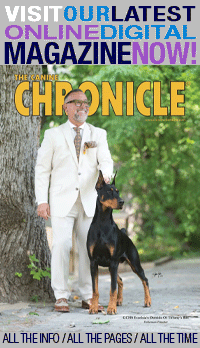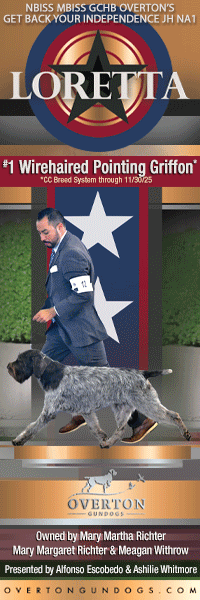Outside the Box – Howard Willets
Click here to read the complete article
276 – February, 2015
By Amy Fernandez
AKC’s early decades redefined the phrase “bumpy ride”. An endless barrage of personal, political, and financial disasters repeatedly threatened to bring down the curtain. Thankfully, things seemed to settle down by the early 1920s – then the president abruptly resigned three months into his second term.
Howard Willets’ short tenure as AKC’s sixth president belies his intense relationship with the organization. Born April 6, 1861, he could be described as “bespoke” AKC material. Willets Point, Queens is one of the few reminders of his family’s 300 year economic and political domination in New York. Fondly known as the Iron Triangle, Willets Point has been shoved out of its customary obscurity in recent years. Invariably, this uninvited media attention focuses on the political posturing surrounding redevelopment plans for one of New York’s few remaining realtime neighborhoods. Best known for its unrivaled goldmine of used car parts, none of this publicity hints at the Willets family’s venerable blueblood heritage or long buried link to AKC history.
Howard’s life followed the script until 1894 when his wife died. Outwardly, it was a classic middle age crisis. He had a lot on his plate, raising two children and managing his spiraling business empire. That explanation doesn’t address the reality; Howard was a bit off-kilter from the start. Despite the demands of work and family, he was equally dedicated to the premier hobby of his social set, Thoroughbreds and hunters. By then, his renown as expert horseman had elevated him to M.F.H. of the Westchester Hounds.
Under these circumstances, his friendship with Hildreth Kennedy Bloodgood was inevitable. Two years his senior, Bloodgood’s family had an equally impressive tenure in Queens, dating back to 1659. Bloodgood also stalked Wall Street as a member of Vernon C. Brown brokers. However, it was his canine and equine accomplishments that secured his reputation. Early brilliance as a polo player, yachtsman, and national saber champion confirmed his uncontainable competitive drive. His personal affiliations as a member of the Knickerbocker, Racquet and Tennis, Metropolitan, and Union clubs certified his elite social position. Countless personal and professional opportunities dictated their eventual collision, and from that moment Howard orbited in the Bloodgood solar system.
Bloodgood entered the horse game in 1888 when he spotted Star of Mepal while honeymooning in Mepal, England. Hackney ponies were trending as state-of-the-art equine transportation. The first one had arrived in America a decade earlier and England’s Hackney Stud Book was only five years old. But Bloodgood knew what he wanted when he saw it. Star of Mepal was the first of almost 200 hackney stallions and mares he imported over the next two years. That necessitated the purchase of the 800 acre Bloodgood Stock Farm in New Marlborough, Massachusetts in 1890. It was ideal for its purpose and the ponies were soon joined by a herd of prize Jersey cattle.
Concurrently, Howard was dabbling in a similar venture a few miles south in Westchester County. After losing his wife, his fascination with animal husbandry morphed into obsession, resulting in one of the most unusual ventures of early twentieth century, progressive farming. He had a knack for envisioning unusual possibilities. Unfortunately, he was about a century ahead of his time in this case.
In 1898 he purchased a 250 acre tract in Westchester, naming it for the Gedney family that had owned the property since 1740. Howard did a lot more than play gentleman farmer at Gedney Farms. He showcased his equine and canine stock by driving around town in a carriage with Dalmatian escorts. That quickly defined him as the town eccentric. It was the tip of the iceberg.
On November 14, 1907 the Washington Herald announced the impending demise of the Gedney Model Stock and Dairy Farm. The article detailed a luxurious routine that had lured curiosity seekers from far and wide. “The prize porkers were curried and manicured daily in boudoir style, and the milk-producing Jerseys were housed in a concrete palace with electric lights and steam heat.” Although it lasted less than a decade, Gedney was a grand affair built on audacious decisions. Topping that list was Howard’s purchase of the world champion jumper Heatherbloom, one of the first residents at Gedney.
By the time that Heatherbloom made his American debut, Mepal was the acknowledged source of America’s best Hackney stock. Bloodgood began showing at MSG’s National Horse Show in 1890. In 1899 he was judging horse shows from coast to coast and running the National when Heatherbloom made his debut and swept the boards.
Howard’s gambles didn’t always pay off. Gedney hemorrhaged cash at an alarming rate. The Washington Herald explained, “Mr. Willets has decided it doesn’t pay to produce milk at a cost of $10 a gallon and raise pork at $118 a pound, chickens at $35 a pair and cows at $300 to $3,500 each.” At the time, meat and poultry cost about 20 cents a pound and milk was about 15 cents a quart. Howard invested over a million dollars in the venture, including a state-of-the-art dairy costing over a half-million. Heatherbloom’s price tag paled in comparison to some of his Jersey cows purchased for up to $3,500 each.
In December, 1907, over 100 Gedney Farms employees got the pink slip for Christmas. New ventures were on the horizon for Howard. His friendship with Bloodgood stemmed from their mutual interest in Jersey cattle and show horses, but that was far from Bloodgood’s only major project. While Gedney Model Farm was winding down in Westchester, things were ramping up in New Marlborough. Bloodgood’s magnificent family estate was also home to Mepal Cockers.
Cockers were rocketing up the charts in 1905, when Watson profiled the breed for his Dog Book. They underwent an almost unbelievable transformation, and Mepal had plenty to do with it. Watson described early Cockers as a hodgepodge of sizes and types reflecting their diverse ancestry. “There was little dependence to be placed upon the results in breeding from this blood of mixed field and Cocker strains…the end of that state of affairs was rapidly approaching, and arrived in the shape of a puppy, Obo II, named after his well-known sire, for the Obo strain had become very prominent in England.”
Obo, whelped in 1879, is considered the first modern Cocker. The Kennel Club granted the breed separate classification four years later and individual recognition in 1893. “To Obo II we owe the sudden elevation of the Cocker and the fixing of type which so quickly changed the appearance of the Cocker benches.” First shown in 1883, within a decade his transformative influence was indisputable. Baby Ruth topped the list of watershed Obo descendants, Watson called her, “One of a brilliant galaxy of stars sent down from the North Country…considered by many ideal in head”. Bred in Canada by Andrew Laidlaw, Bloodgood was lovestruck the moment he saw her at the 1894 American Spaniel Club show. “Baby Ruth, both before and after becoming the property of Mr. H.K. Bloodgood, had a brilliant career.” She set the course for Mepal Cockers, “there has been little to interfere with the success of the Mepal Kennels, and as the stock is breeding on and producing an annual crop of winners and plenty of good bitches to breed from…the upper hand in blacks is held at this kennel.”
Always the dour Scot, Watson was never generous with praise. He found plenty to criticize about Cockers. However, he did concede that “one class did show improvement, and that was the particolor…Mr. Bloodgood also dabbled a little in this variety although for a long time it was evident that the blacks were his favorites.”
By then, Mepal was equally famed for its ponies and Cockers because Baby Ruth wasn’t the only ace in Bloodgood’s winning hand. According to The Modern Dog Encyclopedia, “many of Obo’s descendants were sent to America. Braeside Bob, one of these, is sometimes called the father of the American Cocker.” Braeside Bob’s legacy extended far beyond his intended purpose as the foundation sire of Mepal particolors. His notable Mepal offspring included Ch. Shotover, Ch. Roue, Ch. Hilma, Ch. Durbar, BIS Ch. Ira, and most importantly, Ch. Iris. The kennel built its reputation on black Cockers but Iris, a particolor, was its all-time top winner.
Bloodgood was immersed in every facet of New York’s dog scene. He joined Westminster in 1903 and entered AKC’s inner circle in 1897, remaining a member of both until his death. In 1904, he began a 14 year stint as president of the American Spaniel Club and immediately began recruiting wealthy members to finance club expenses. He started close to home with his daughters, Vera and Gladys, and their husbands and, of course, his friend Howard.
As usual, Howard jumped in at the deep end. Within a year, he was up to his eyeballs in the spine-tingling world of show dogs. He registered his Gedney Farms kennel prefix that year and two years later Gedney hosted the inaugural Westchester Kennel Club show, which he helped to found and continued to guide as president. It drew a respectable entry of 583. BIS went to the legendary Ch. Warren Remedy and the show quickly settled into its time honored niche as a social event and a purebred showcase.
That wasn’t the only thing that kept Gedney in the news. On September 29, 1909, George Pulitzer sponsored an air race commemorating the 300th anniversary of Henry Hudson’s famous voyage. One competitor barely made it out of Manhattan before going down in flames at Gedney Farms. A week later Wilbur Wright did better completing a flight around Manhattan, but the fiery disaster at Gedney garnered equal publicity. Some would have called it an omen because a far worse conflagration put Gedney in the headlines three months later as the Times reported December 1:
“FIRE RUINS MANSION ON THE GEDNEY FARM; Loss on Show Place Near White Plains, Owned by Howard Willets, Is $300,000. NEIGHBORS FIGHT BLAZE As House Was Burning Mr. Willets Learned That He Had Been Awarded $277,999 in a Suit.
A Spectacular daylight fire totally destroyed the large manor house on Gedney Farm, White Plains, the country place of Howard Willets, yesterday morning. Fanned by a stiff northwest gale, the flames consumed the building in less than an hour, although the entire Fire Department of White Plains and many of Mr. Willets’s wealthy neighbors fought hard to save it.”
Gedney was an unmitigated financial disaster. However, in less than a decade, its pastoral charm had become a magnet for tourists. Howard had his failings, but he was a visionary. When any aspect of his life hit the skids he had no problem thinking outside the box. In reality, he was one of those rare individuals who had trouble doing otherwise. Today, the rustic appeal of remodeled barns is well-known, but the concept was about as far out in left field as you could get a century earlier. He took a gamble and leveraged its visual appeal and accessibility to cash in on the burgeoning mania for country vacations.
In 1912, famous Gedney barn became a luxury hotel. In another brilliant stroke, he handed the job to Kenneth MacKenzie Murchison, who was just hitting his stride as an American architect. Styled after a French chateau, the resulting Gedney Farms Hotel featured long wings, a turreted front, modern elevators, and 300 guest rooms with private baths. Amenities included a barber shop, grocery store, formal ballroom with hardwood floors and electric lights, a billiard room, indoor pool, ice rink, bowling alley, squash courts, formal gardens and tennis courts. The Gedney Country Club down the road, offered an 18 hole golf course, polo fields, kennels and a stable of riding horses and polo ponies.
Howard relocated his animals to New Marlboro. By then, Bloodgood was more than his neighbor. In April 1910, Gladys Augusta Bloodgood married her childhood companion Josiah Macy Willets at the Bloodgood’s New York townhouse. The young couple nestled into their new home sandwiched between their in-laws in New Marlboro and carried on the tradition with Cassilis Stock Farm and Cocker kennel.
After serving as a first lieutenant in the Army remount service during World War I, Howard’s life seemed to be on a predictable, steady course. The Willets/Bloodgood clan was primed for a triumphant Westminster in 1918, which explains why Bloodgood missed several AKC meetings that week. Even so, it’s doubtful that anyone was surprised by his election as First Vice President on February 19. But the dog world was definitely shocked by his unexpected death at age 52 the next day.
At the same meeting, Hunnewell accepted another term as president, taking him to the end of a 20 year stretch in office. Howard was slotted in as Second VP at that meeting.
Although equally enmeshed in the AKC power structure, he was a comparative newcomer to this inner sanctum. But he quickly moved up the ranks, heading the finance and licensing committees, and confirming his reputation as a smart, likeable, capable manager, and precocious networker. But AKC kept him on the backburner because there was no denying the fact that he was a proverbial loose cannon.
Bloodgood’s unexpected death was soon followed by Hunnewell’s impending resignation, and Howard’s flaws seemed less significant. He stepped in as AKC’s sixth president on February 21, 1921. He was at the top of his game in 1923 when he started his second term as AKC president on February 20th. Then he kicked it all to the curb, abruptly resigning on May 15th. Recounting this event for the AKC Sourcebook 60 years later, the characteristically dispassionate historian John Marvin didn’t conceal his feelings. “He served until 1923, when he found that his personal responsibilities did not permit him to devote what he considered adequate time to his duties.”
Howard gave it up for love. But that didn’t warm any cold, stony hearts at AKC, especially since 62 year-old Howard had met 24 year-old Elyse Young at their headquarters where she then worked as one of their growing army of management personnel. They married two weeks later on May 24. Another of Howard’s unconventional decisions paid off. By all accounts, it was a happy marriage. He served on various AKC committees and remained a delegate for the San Mateo K.C. until his death at age 77 in 1938. He ensured a comfortable future for Elyse. Sadly, her subsequent disastrous rebound marriage culminated in 1941 when she put her head in the oven and went to join Howard on the other side.
It’s not easy to define Howard Willets’ contribution to the purebred dog world. Calling his career unconventional is an understatement. Some would consider it disappointing. AKC didn’t even run an obituary for him in the Gazette. However, his message is truly significant. His career should remind us that life has much to offer outside of this box.
Short URL: http://caninechronicle.com/?p=70354
Comments are closed












